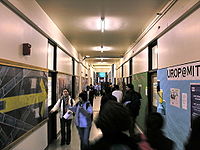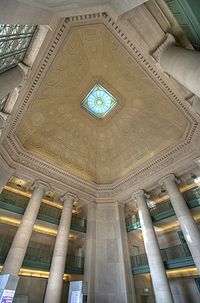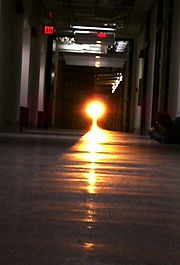
Infinite Corridor
Encyclopedia

Massachusetts Institute of Technology
The Massachusetts Institute of Technology is a private research university located in Cambridge, Massachusetts. MIT has five schools and one college, containing a total of 32 academic departments, with a strong emphasis on scientific and technological education and research.Founded in 1861 in...
, specifically parts of the buildings numbered 7, 3, 10, 4, and 8 (from west to east). The corridor is important not only because it links those buildings, but also because it serves as the most direct indoor route between the east and west ends of the campus. The corridor was designed as the central spine of the original set of MIT buildings designed by William W. Bosworth
William W. Bosworth
William Welles Bosworth was an American architect whose most famous designs include MIT's Cambridge campus, the AT&T Building in New York City, and the Theodore N. Vail mansion in Morristown, New Jersey , now the Morristown Town Hall...
in 1913.
"Traffic" in the corridor can be quite heavy at times, and in fact one legendary "hack
Hacks at the Massachusetts Institute of Technology
Hacks at the Massachusetts Institute of Technology are practical jokes and pranks meant to prominently demonstrate technical aptitude and cleverness, or to commemorate popular culture and historical topics. The pranks are anonymously installed at night by hackers, usually, but not exclusively...
" (practical joke
Practical joke
A practical joke is a mischievous trick played on someone, typically causing the victim to experience embarrassment, indignity, or discomfort. Practical jokes differ from confidence tricks in that the victim finds out, or is let in on the joke, rather than being fooled into handing over money or...
) in 1985 involved placing traffic signals, lane markings, and highway-like signs along its length. On occasion, students in the Transport Lab of the Department of Civil and Environmental Engineering (CEE) have studied foot traffic in the Infinite Corridor, as a safer, more accessible model of highway traffic
Traffic
Traffic on roads may consist of pedestrians, ridden or herded animals, vehicles, streetcars and other conveyances, either singly or together, while using the public way for purposes of travel...
. One student report made the following observations about the informal rules that seem to apply to Infinite Corridor traffic:
"The rules of the road for the Infinite Corridor include: stay to the right, limit group size, pass on the left, form a line at bottlenecks, don't stop/slow down, no tailgating, traffic within corridor has right of way, no physical contact and no eye contact.
Twice per year, in mid-November and in late January, the corridor lines up with the plane of the ecliptic
Plane of the ecliptic
The plane of the ecliptic is the plane of the Earth's orbit around the Sun. It is the primary reference plane when describing the position of bodies in the Solar System, with celestial latitude being measured relative to the ecliptic plane. In the course of a year, the Sun's apparent path through...
, causing sunlight to fill the entire corridor, events that are celebrated by students and staff.
Location
An outside grand stairway leads up from Massachusetts Avenue to Lobby 7, the main entrance to the Infinite Corridor. This location is often called "77 MassAve", an abbreviation of its official street address; the street itself forms the western boundary of the main or central campus. The MIT Student Center (Building W20) is located directly across the street, at 84 Massachusetts Avenue.Nearby bus stops serve MBTA buses from Harvard Square
Harvard Square
Harvard Square is a large triangular area in the center of Cambridge, Massachusetts, United States, at the intersection of Massachusetts Avenue, Brattle Street, and John F. Kennedy Street. It is the historic center of Cambridge...
, and from Back Bay across the Charles River
Charles River
The Charles River is an long river that flows in an overall northeasterly direction in eastern Massachusetts, USA. From its source in Hopkinton, the river travels through 22 cities and towns until reaching the Atlantic Ocean at Boston...
via the Harvard Bridge
Harvard Bridge
The Harvard Bridge carries Massachusetts Avenue from Back Bay, Boston to Cambridge, Massachusetts. It is the longest bridge over the Charles River....
, as well as various shuttle buses. Food vendor trucks often park in designated spaces near the entrance.
Lobby 7

Lobby 7 is frequently used for formally-scheduled or impromptu concerts. During the 1970s, two large pillars flanking the entrance to the Infinite Corridor were partially wrapped in paper and used by the liberal "Alternative Advertising" and somewhat less liberal "Pillar Productions" where students would scrawl responses to issues of the day such as nuclear power or whether disco sucked. A display of Air Force
United States Air Force
The United States Air Force is the aerial warfare service branch of the United States Armed Forces and one of the American uniformed services. Initially part of the United States Army, the USAF was formed as a separate branch of the military on September 18, 1947 under the National Security Act of...
art was once withdrawn after vandalism in the lobby.
Banners are often hung from the upper levels of Lobby 7, including the occasional hack
Hack
-Computers and technology:* Hack to break into computers and computer networks* Hack , an inelegant but effective solution to a computing problem* Hack , participation in a computer programmer subculture...
such as "Don't let the Grinch steal your Christmas" in reference to the common complaints about the campus Christmas tree. The cavernous interior space of Lobby 7 is frequently the site of large-scale indoors hacks.
Decorations
The walls lining the Infinite Corridor were painted stark "Institute Gray" with black doorway trim until Spring 1970, when a number of wall murals appeared. With two notable exceptions, the paintings were soon replaced by bulletin boards and enclosed display cases which remained largely unchanged for several decades. A Summer 2010 renovation installed more-durable boards, and more clearly marked many portions of them as reserved for exclusive use by one specified student activity or another.The Cashier's Office wall was painted as a giant dollar bill for over 25 years (and was the subject of a number of hacks), but this was eventually removed and replaced with a glass wall when that space was converted to a community lounge. A picture of the old wall mural is etched into the glass, as a historical marker. The oldest remaining wall mural (near the Admissions Office) is an early-1970s style colorful painting of a "multicultural" group of people walking quickly. Having survived many renovations and repaintings of the Infinite Corridor, the mural now is a carefully-preserved relic of that era.
Some adjacent laboratories, notably those of the Department of Materials Science and Engineering (Course 3), now have floor-to-ceiling glass walls and large posters or display cases explaining some of their research activities.
Lobby 10
A two-story atrium space at the half-way point of the corridor, known as Lobby 10 (part of the MacLaurin Buildings in Building 10, underneath the Great Dome), features walls on which are engraved the names of MIT alumni who died in each of several wars. In Lobby 10, it is quite common to find several booths or tables advertising upcoming events, or students engaged in other public activities and demonstrations, such as juggling or dancing. Often, there are fund-raising activities, such as selling used books, tickets for shows, items made in the MIT GlassLab, or Chinese pastries.Different levels
The Infinite Corridor has five levels. The first floor (called the "ground floor" by some) is the most traveled level, and is often the only one referred to as the Infinite Corridor. It is half a floor above ground level at Massachusetts Avenue (the west end), and in areas is a full floor up, with a parking lotParking lot
A parking lot , also known as car lot, is a cleared area that is intended for parking vehicles. Usually, the term refers to a dedicated area that has been provided with a durable or semi-durable surface....
entrance passing underneath (this entrance crosses the basement-level corridor at grade). At its east end it is also about half a floor up, with nearby stairs going up to the second floor and down to the first floor of adjacent, newer buildings, which were built with lower ceilings. The Infinite Basement Corridor mirrors the first floor passage, but connects to the extensive below-grade system of tunnels connecting many buildings.
MIThenge

Archaeoastronomy and Stonehenge
The prehistoric monument of Stonehenge has long been studied for its possible connections with ancient astronomy. Archaeoastronomers have claimed that Stonehenge represents an "ancient observatory," although the extent of its use for that purpose is in dispute...
(although the type of alignment bears a closer relationship with that of Newgrange
Newgrange
Newgrange is a prehistoric monument located in County Meath, on the eastern side of Ireland, about one kilometre north of the River Boyne. It was built around 3200 BC , during the Neolithic period...
and Maeshowe
Maeshowe
Maeshowe is a Neolithic chambered cairn and passage grave situated on Mainland, Orkney, Scotland. The monuments around Maeshowe, including Skara Brae, were designated a UNESCO World Heritage Site in 1999. It gives its name to the Maeshowe type of chambered cairn, which is limited to Orkney...
in that the sunlight passes through the mass of the buildings rather than through the standing stones of Stonehenge). These alignments occur on several days around January 31 and November 11. The phenomenon was spotted, calculated, and popularized in 1975-76 according to a Sky and Telescope article. The MIThenge site has more information and predictions for when the phenomenon will occur.
Demonstrations
During the 1960s, a common Technology Day demonstration used the unobstructed length of the corridor to demonstrate the speed of lightSpeed of light
The speed of light in vacuum, usually denoted by c, is a physical constant important in many areas of physics. Its value is 299,792,458 metres per second, a figure that is exact since the length of the metre is defined from this constant and the international standard for time...
in a simple, direct way. A strobe light
Strobe light
A strobe light or stroboscopic lamp, commonly called a strobe, is a device used to produce regular flashes of light. It is one of a number of devices that can be used as a stroboscope...
, photocell, and oscilloscope
Oscilloscope
An oscilloscope is a type of electronic test instrument that allows observation of constantly varying signal voltages, usually as a two-dimensional graph of one or more electrical potential differences using the vertical or 'Y' axis, plotted as a function of time,...
were positioned at one end of the corridor, and a mirror at the other. The round-trip time was about two microseconds. The photocell picked up both the direct and reflected flashes. The flash duration being well under a microsecond, the result was two nicely separated pulses on the oscilloscope screen.
External links
- MIThenge and photo
- Alan Eliasen has lots of information about MITHenge solar and lunar events and predictions for future dates.
- How MIThenge Got Its Start, Slice of MIT blog 2011

